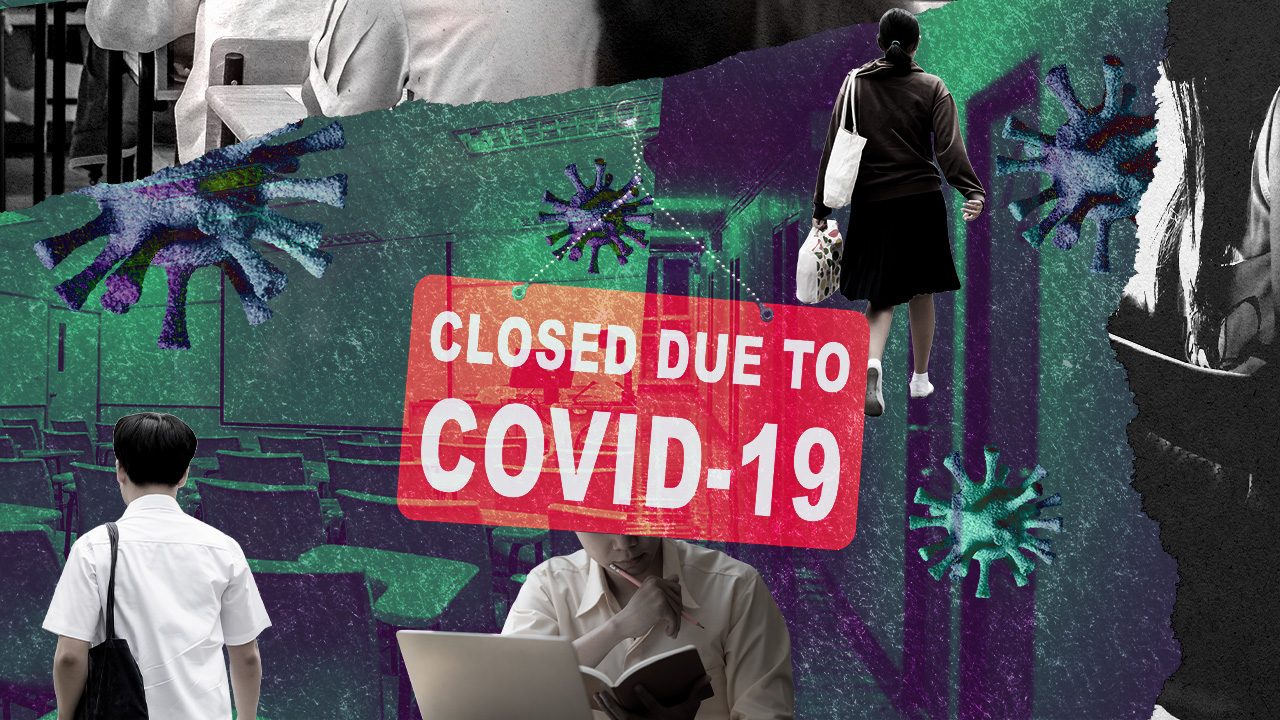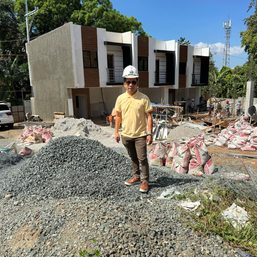SUMMARY
This is AI generated summarization, which may have errors. For context, always refer to the full article.

It was supposed to be a break for the students – a month, or maybe two at most.
The coronavirus had arrived in the Philippines. The government had yet to announce local transmission in February, but parents of a Quezon City-based dorm may have started to get a feeling that this would escalate, and started moving their kids out.
“When there were talks of a lockdown, we started to get a view of what’s going to happen, because the kids needed to go home. It was sudden – as early as February, many were booking [flights], and many wanted to leave,” Alexander Sargeant, the dorm’s employee and tenants relations officer, told Rappler in a mix of English and Filipino.
The anticipations of the dorm and their tenants began to manifest. While confirmed cases were less than 100 by the start of March, classes were suspended for a week beginning March 10.
Within a week, President Rodrigo Duterte placed Metro Manila, and then the entire Luzon on lockdown. Sargeant prepared the staff to take care of the students still inside. There were around 10 left, he said.
It’s what they do best: make the dorm a second home to them. They were determined to continue quality service – even as sales began to go below target.
Seven months into the pandemic, the situation is pretty much the same. Coronavirus epicenter Metro Manila is still under a quarantine measure that is less restrictive but still limits people’s movements.
On October 5, over 24 million Filipino students started classes again, though remotely, and with the pandemic still raging with over 360,000 cases of infections. (WATCH: Empty classrooms as Philippines starts classes during pandemic)
Throughout the pandemic, unemployment has reached an all-time high and thousands of small businesses have closed. In August, the Philippines was pushed into recession.
The shift to remote learning created a ripple effect throughout the education sector, affecting businesses that primarily cater to students.
Dorm closure
A 7-story dorm on Katipunan once buzzed with students asleep on the communal couches, “study” groups having Netflix parties in the outdoor study area, and the occasional outsider boyfriend or girlfriend waiting for a partner in the lobby, because that’s as far as they were allowed. Swiftly, as the lockdown was declared, it became a ghost town.
The dorm did not normally provide food for their tenants, but now the staff had to, as some of the tenants were too young to secure a quarantine pass. The rooms didn’t have kitchens either, and so the staff had to cook for the dormers to help everyone get by.
Fortunately, the higher-ups kept the stuck employees posted through constant communication in Messenger and Viber groups. It was in these channels, too, that the dorm staff received news they never hoped to see.
What seemed like a school break turned out to be the beginning of an end. It was only two months before the dorm decided the pandemic was too uncertain for them to keep operating. By May, parents had received email notices that their kids had to move out by August.
When asked if he had a plan, Sargeant said no.
“Because I thought it would just be a vacation, maybe two months. But when it started to become clearer that schools would be online, the dorm became very much affected… It was a shock when it all happened. It was so unexpected,” he said in a mix of English and Filipino
Like the staff, some students left their belongings, thinking it would only be a matter of time before classes would return. Dorm personnel had to assist in packing their things and sending them back to their respective provinces.
“Nakakalungkot, kasi when we did the packing, mayroong mga tenants na nag-re-request na video call sila. So we’re packing things na naka-video call kami. Alam mo yun, nakakatawa, nagtatawanan, pero na-pack mo na yung huling box, parang, ‘yun na ‘yon?” said Sargeant.
(It was sad, because when we did the packing, there were tenants who requested video calls. So we’re packing things while on video call. You know, it was funny, we were laughing, but when you pack the last box, you think, that was it?)
“It would have been better if it was face to face. We can say proper goodbyes. But we’re proud that somehow we made an impact on their lives. We became, literally, ates and kuyas for them,” he added in a mix of English and Filipino. For Sargeant, it was not just a business lost, but a culture.
The staff were offered retrenchment, and were told that if the dorm were to open again someday, they could still come back. If someone bought the building from the company, the administration would vouch for the staff’s hiring as well. Sergeant said all retrenched employees were given government assistance and separation benefits.
Sargeant also said that the owners of the building, who also own other hotel properties and accommodations, were looking into converting the dorm into a quarantine facility for overseas Filipino workers (OFWs).
“One of their hotels has an OFW help center. So [there were talks] if we can provide homes for the OFWs, but I don’t know if it manifested,” he said. Rappler tried to contact the dorm administration to confirm, but they have not replied.
From success to weak demand
For businesses, realtors, and ordinary people renting out their units in school districts, thousands of pesos in income could be lost due to the suspension of physical classes during the pandemic.
Rent in dorms and bedspaces in the Katipunan area range from around P4,550 to P18,000 a month, based on rates listed in dorms’ official websites and other real estate companies like Lamudi. For high-rise condominiums in the same area, 10 listings yielded an P18,700-average for a monthly rental.
Meanwhile, renting in the University Belt is cheaper, with dorm owners charging students more or less P4,570 a month. Additionally, condo-sharing around España Avenue costs P2,000 to 4,000 per unit, as posted in the official websites of residence firms. The higher-end condominiums around U-belt cost about P17,214 on average.
For anyone looking for a place to stay near school in Metro Manila, chances are there’s a Facebook group for the area of interest – from the Katipunan area to the University Belt. Even without face-to-face classes, quick searches show groups are still active with listings, but sellers were lucky if people engaged.
Chester Cardenio, who rents out a unit in the Mendiola-Malacañang area for P12,720 a month, posted photos of his unoccupied unit in a “dorm hunters” Facebook group on September 16. As of posting, the listing is still up, with zero comments or reactions.
“Mahirap po makakuha ng tenant sa ngayon kasi students talaga bumubuhay sa area namin. Kahit mga sari-sari store, restaurants etcetera, nagsara na. Halos lahat ng pinauupahan namin umalis na,” he told Rappler over Facebook Messenger.
(It’s difficult to get a tenant now because students are really the ones who bring livelihood in our area. Even the sari-sari stores, restaurants, and other establishments have closed. Almost all of our renters have left.)
Cardenio, 30, said so far he has been able to close a deal with a worker from Malacañang, but not without having to reduce monthly dues.
He and his partner have several properties – all around the U-Belt area: Mendiola, Pureza, and Quiapo. Once in hot demand due to thousands of students all around and workers from nearby Makati, the couple struggles to attract tenants for what used to be their only source of income.
“By the end of March, some were already starting to move out because they were uncertain whether classes would resume. We were also stressed because our tenants suddenly left. Some left their units damaged or didn’t pay their bills. We waived the deposit for some because we felt bad for them,” he said in Filipino.
They transformed one of their spaces into a convenience store to get by. “Okay naman kahit papaano, kaysa wala (It’s okay, better than nothing),” he said.
Pandemic casualty: Review centers
During the pre-pandemic era, some students invested in review centers as they geared up for competitive university and college entrance tests (CETs), enrolling in programs that costs from P550 to P23,500, depending on the program of choice and the span of the tutorial. These include non-CET tutorial programs as well.
But as schools shifted to remote learning, the demand for review center programs changed. Several colleges have also begun to suspend their entrance exams. As schools continue to experience a decline in enrollees, review centers also confront dwindling numbers of students.
This is the case of a 20-year-old review center in Quezon City that had to close its two centers due to low numbers of students availing of their services, making it difficult to maintain office spaces. The owners, however, refused to disclose details of revenue losses.
While the government has allowed some services like tutorial centers to operate again in areas under general community quarantine, parents and students are still hesitant to go out of their homes for fear of contracting the virus. And because most students who avail of tutorial services are minors, they are prohibited from stepping out of their houses.
“Majority of our clients now are really from 8 to 12. This is the age wherein you really cannot go out, so it’s 20 and below. We had to close the centers. Nobody, nobody is going to come over,” said Grace Reyes*, one of the owners of the review center.
Reyes, speaking to Rappler via Zoom call, said that since quarantine measures were imposed in Metro Manila, they needed to think of ways to keep their business afloat.
“We could not offer them face to face, what we did was, we tweak the programs together with the team, and then we provide [services] that would suit online delivery. We tweak the programs so that we could provide the enrichment classes online,” Reyes added.
But the digital shift, Reyes said, didn’t help as they experienced a “significant” decline in clients, which she attributed to the “unfolding uncertainty” about remote learning.
“So even if the students will not be commuting, even if there was no problem about who will pick you up, bring you to the center, and then when you’re done, pick you up again – even if that’s not the situation [anymore,] there’s [probably] a lot of hesitation,” Reyes said.
Even as their centers physically close, Reyes said they have not needed to lay off their employees – but at the cost of her and her co-owners shelling out money from their own pockets to pay their salaries.
“It is a temporary solution to shell out because financial resources are finite,” Reyes said.
Turning crisis into opportunity
Meanwhile, Laguna-based review center Brain Train saw the opportunity to strategize in the middle of the health crisis.
In a Zoom interview with Rappler, Randy Ladaga, director of Brain Train, said that the pandemic enabled them to strengthen their online presence through virtual classrooms.
“Those who signed up for face-to-face, we were able to convince them to go online and I think, after so many batches, we were able to get as many students as we were expecting, as if it were face to face,” Ladaga said.
Ladaga added that they invested in equipment for virtual classes like laptops and cameras to make the learning experience of students worthwhile.
“Almost everything is live. Lessons are not recorded. We repeat lessons in every class. We tried to not disappoint and I think we did not disappoint,” he said.
“Students who live far from our offices, for example in Pangasinan, those we don’t usually reach – they’re able to avail of our services now. So that’s one advantage. We also have a student from Qatar,” Ladaga said.
For Ladaga, Brain Train’s established name in tutorial services also helped them to cope with the shift to remote learning, adding that they didn’t find it hard to market their virtual classrooms to students and parents.
Ladaga said that while they lost “a little” number of students registered in their program, they were able to gain some clients by increasing the number of time slots for their virtual classes. Unlike before when face-to-face sessions were strictly from 7 am until 3 pm.
“Ngayon mayroon kaming as late as mga 10:30 pm, and as early as 7 am,” Ladaga said. (Now, we have classes until as late as 10:30 pm, and as early as 7 am.)
Asked about future plans, Ladaga said that should face-to-face classes resume next year, Brain Train’s virtual classroom will remain alongside its pre-pandemic tutorial services.
“I [can’t see] much of a difference anymore about how we were able to teach through face-to-face setup and how students are able to learn online. We can still improve and by next year, this will be a good option for them,” Ladaga said.
As the pandemic brings uncertainties to people and businesses alike, Ladaga, Reyes, Cardenio, and Sargeant remain optimistic. With some struggling and others closed, the workers find ways to be flexible and survive.
“In this kind of situation, there’s no other way to go but to be hopeful, because should you choose not to be hopeful it’s not going to benefit you. I think at this point, if everything – all the uncertainty that is unfolding, the only thing that will help you through, is to become hopeful,” said Reyes. – with reports from Charles Magallanes/Rappler.com
*Name has been changed at the interviewee’s request for privacy and anonymity.
Add a comment
How does this make you feel?


![[Time Trowel] Evolution and the sneakiness of COVID](https://www.rappler.com/tachyon/2024/02/tl-evolution-covid.jpg?resize=257%2C257&crop=455px%2C0px%2C1080px%2C1080px)











![[OPINION] Symbols of Pinoy greatness: The Philippines’ tallest statues](https://www.rappler.com/tachyon/2024/02/the-victor-february-21-2024.jpg?resize=257%2C257&crop=494px%2C0px%2C1080px%2C1080px)
There are no comments yet. Add your comment to start the conversation.